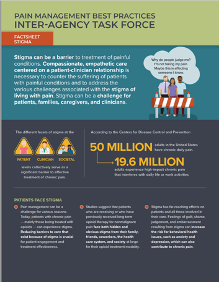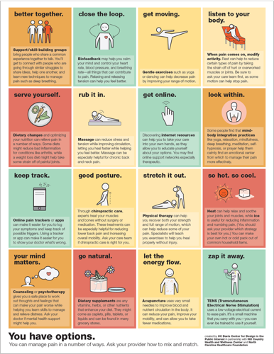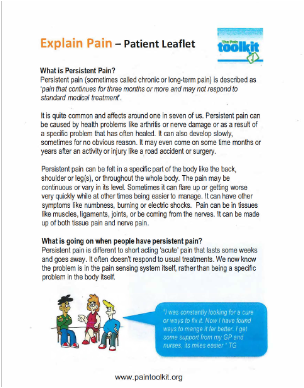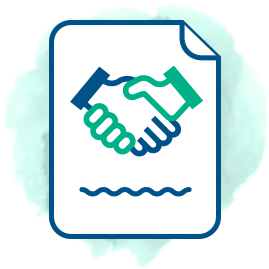Pain Resources & Tools
Whether you need guidance for connecting with your patients, guidelines for managing their pain, or strategies for helping to prevent medication misuse or manipulation, you will find a range of tools here that will help you navigate treatment planning for patients living with pain.
Tools for Talking to Patients Pain Management Guidelines Opioid Use & Misuse Guidance Treatment Planning ResourcesDevelop Deeper Dialogues With Your Patients
Pain Management Guidelines
American Academy of Pain Medicine (AAPM) Pain
Treatment Guidelines*
AAPM guidelines are intended as educational tools for healthcare providers and are based on clinical expertise and a review of the relevant literature by diverse groups of highly trained clinicians. This site includes a collection of the most up-to-date guidelines and consensus recommendations.
*Collegium Pharmaceutical, Inc. has previously provided funding to this organization. However, Collegium does not influence or control the contents and information on its website which is being provided here for informational purposes only. Go to AAPM Guidelines >CDC Guideline for Prescribing Opioids
for Chronic Pain

The Centers for Disease Control and Prevention (CDC) developed these guidelines to improve communication between providers and patients about the risks and benefits of opioid therapy for chronic pain and reduce the risks associated with long-term opioid therapy, including opioid use disorder and overdose.
CDC Prescribing Opioids Guidelines PDF >Practice Guidelines for Chronic Pain Management:
An Updated Report by the American Society of Anesthesiologists (ASA)
Practice guidelines were developed by an ASA task force to optimize pain control; enhance functional abilities and physical and psychological well-being; enhance patient quality of life; and minimize adverse outcomes.
CDC Prescribing Opioids Update >Noninvasive Treatments for Acute, Subacute, and Chronic Low Back Pain: A Clinical Practice Guideline From the American College of Physicians (ACP)
Using the ACP grading system, the committee based these recommendations on a systematic review of randomized, controlled trials and systematic reviews published through April 2015 on noninvasive pharmacologic and nonpharmacologic treatments for low back pain.
Go to Guidelines >US Department of Veterans Affairs: Opioid Taper
Decision Tool

This tool assists primary care providers in determining if an opioid taper is necessary for a specific patient, and provides guidance on performing the taper, along with follow-up and support during the taper.
Opioid Taper Decision Tool PDF >Opioid Use and Misuse
Substance Abuse and Mental Health Services
Administration (SAMHSA)
Articles on addressing the current opioid environment with information on getting help, current topics, letters and toolkits, public health efforts, and programs and campaigns.
Visit SAMHSA >US Department of Health and Human Services (HHS) Safe Opioid Prescribing

Overview of best practices for prescribing opioids—plus links to additional tools and resources.
Safe Opioid Prescribing >American Medical Association (AMA): Promote Safe Storage and Disposal of Opioids and All Medications

Resource that addresses the risks of prescription opioids and other medications if they are not taken as prescribed, with steps needed to ensure safe storage and disposal of expired, unwanted, or unused medications.
AMA Opioid Disposal PDF >NIH National Institute on Drug Abuse (NIDA)
Website dedicated to pain management. Includes research, the latest science, trends and statistics, and resources for researchers, medical professionals, patients, parents, and children. Includes links to other NIDA sites and social media.
Visit NIDA >American Academy of Pain Medicine (AAPM):
Tools for Practice*
Helpful resources for physicians to assist practicing pain physicians treat their patients with pain.
*Collegium Pharmaceutical, Inc. has previously provided funding to this organization. However, Collegium does not influence or control the contents and information on its website which is being provided here for informational purposes only. Go to AAPM Pain Tools >American Academy of Family Physicians (AAFP):
Chronic Pain Management Toolkit

Toolkit designed to help family physicians identify gaps in practice flow, standardize evaluation and treatment of patients with chronic pain, and facilitate conversations surrounding pain and treatment goals, as well as identify and mitigate risk.
AAFP Pain Toolkit PDF>Resources for Developing a Treatment Plan

Read selected articles for professionals who manage pain.
American Academy of Orthopaedic Surgeons: The Rules
for Opioid Prescribing in 2018
NIH NCCIH: Complementary, Alternative, or Integrative
Health: What’s in a Name?
HHS Overdose Prevention Fact Sheet
The fact sheet provides a summary of how various government agencies are addressing potential misuse, abuse, and prevention following the release of the HHS Overdose Prevention Strategy.
Overdose Prevention Fact Sheet >
International Association for the Study of Pain (IASP) Integrative Pain Management Fact Sheet
How are research studies building an "evidence base" for managing pain care with integrative approaches? This fact sheet examines the research methods used and why external and internal validities are important.
Integrative Care PDF >




